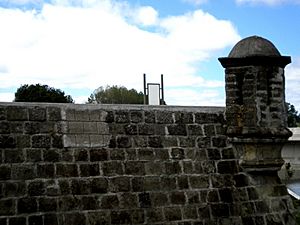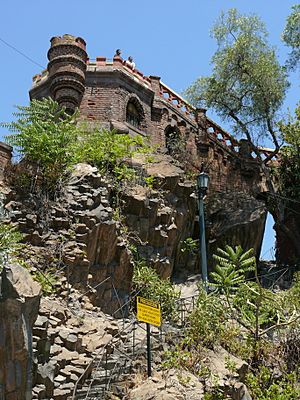Manuel Olaguer Feliú facts for kids
Quick facts for kids
Manuel Olaguer Feliú
|
|
|---|---|
| Born | 27 December 1759 Ceuta, Spain |
| Died | 7 June 1824 (aged 64) La Coruña, Spain |
| Allegiance | |
| Service/ |
Spanish Army |
| Years of service | 1770–1824 |
| Rank | Field Marshal |
| Commands held | |
| Battles/wars | |
| Awards | |
| Signature | |
Manuel Olaguer Feliú (born December 27, 1759 – died June 7, 1824) was a Spanish military engineer. He was famous for building and fixing forts in Chile when it was a Spanish colony. He also took part in the wars where Chile and Peru fought for their independence from Spain. Later, he became a top military leader in Spain.
Contents
Early Life and Military Training
Manuel Olaguer Feliú was born in Ceuta, Spain, on December 27, 1759. His family was from Catalonia. His cousin, Antonio Olaguer Feliú, was an important leader in South America and a war minister for King Carlos IV of Spain. Manuel followed his family's path and joined the military in 1770 as a cadet.
By 1778, he became a sub-lieutenant in the Royal Engineers. He received his training in cities like Valencia, Madrid, and Gibraltar. In 1781, he fought in a war against England.
Work in Colonial Chile
In 1787, Manuel was sent to Valdivia, Chile, as a Captain in the Royal Engineers. Chile was a Spanish colony at that time. Later, he moved to Chiloé, another part of Chile, to check its defenses. He stayed there for two years. During this time, he helped build a new road between Valdivia and Chiloé in 1789. He returned to Valdivia in November 1790.
Building Forts in Osorno
Between 1792 and 1793, Manuel was involved in a conflict with the Huilliche people in the area. In August 1793, he joined an expedition that took over the old city of Osorno. After the city was rebuilt, he became its first Superintendent, Military Commander, and Judge in 1796.
Under his command, two stone forts were built. One was called Fort San José de Alcudia, located by the Bueno River. The other was Fort San Luis, by the Rahue River in Osorno. This fort later became known as Fort Queen Louise.
Manuel then returned to Valdivia to manage its fortifications. He also created a new plan for the city's layout, which was used until 1909.
Role in Independence Wars
In 1807, Manuel became a member of the Extraordinary Council of Government in Valdivia. In 1809, he took charge of the Royal Corps of Engineers. He also became the Deputy Inspector of militias in Chile.
Supporting the King in Chile
In 1810, Manuel was appointed to a special council that watched over events in Chile. At this time, the independence movement began in Chile. Manuel chose to support the King of Spain. He attended secret meetings to plan against the revolutionaries. He was even suggested as a candidate for the presidency of Chile by those who supported the monarchy.
Manuel wrote a diary about these difficult times. It was called "Relation of what occurred in the Kingdom of Chile from 25 May 1810 until the erection of its Council of Government." Because of his loyalty to the King, he was sent away to Chillán. Eventually, he was allowed to go into exile in Lima, Peru.
Return to Chile and Later Battles
The Viceroy of Peru sent Manuel on a ship to help the King's army in Chile. However, he was captured with other leaders in Talcahuano in 1813. He was released in 1814. He held several public jobs, including a role in a council called by Francisco Casimiro Marcó del Pont, who was the last Spanish Governor of Chile.
Manuel was promoted to the rank of Brigadier by the Viceroy of Peru. The King later confirmed this promotion.
In 1816, Brigadier Manuel Olaguer Feliú designed and built two forts on Santa Lucía Hill in Santiago, Chile. These forts were made of stone and could hold eight or twelve cannons each. He also designed a building for storing ammunition and housing soldiers.
On August 10, 1816, he was asked to find a place to train troops. He is remembered as one of the most important military engineers in Chile's history.
After the King's army lost the Battle of Chacabuco to General José de San Martín's army, Manuel returned to Peru. He was one of the commanders of the fleet that brought the remaining Spanish soldiers back to El Callao.
Final Years and Recognition
Between 1818 and 1822, Manuel Olaguer Feliú was a Field Marshal. He served as Director of the Royal Engineers and Deputy Inspector in Peru. He joined the War Council, led by Viceroy Pezuela. Later, he was appointed to a council that tried to make peace in Peru. In this role, he discussed surrender terms with General José de San Martín for El Callao.
In 1819, the King of Spain honored him with the Grand Cross of San Hermenegildo.
Manuel returned to Spain. He became the Director of the Royal Engineers and Deputy Inspector in Galicia. He died in A Coruña, Spain, in 1824. At the time of his death, he was the Captain General of Galicia.
See also
 In Spanish: Manuel Olaguer Feliú para niños
In Spanish: Manuel Olaguer Feliú para niños



